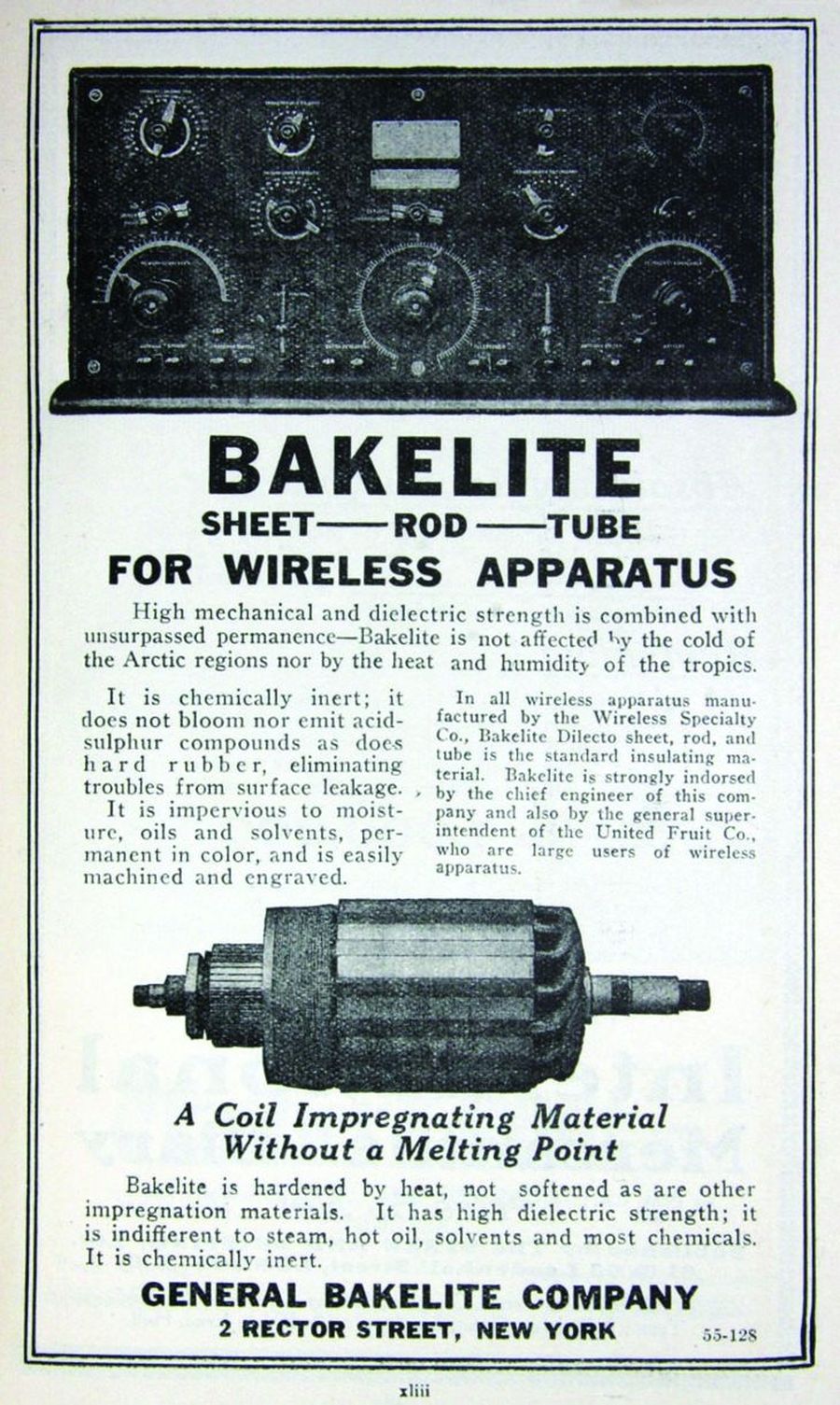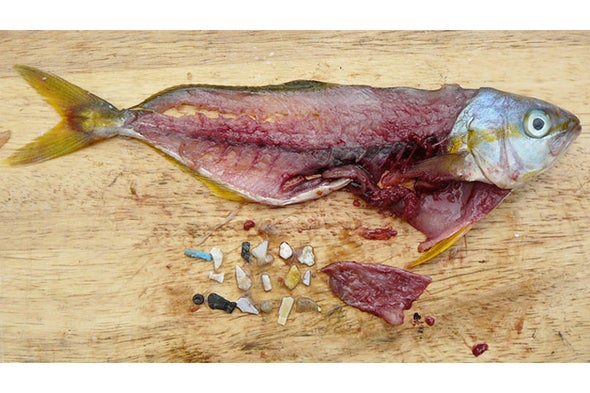Microplastics: The Invisible Threat
Not long ago was plastic almost completely absent in the day to day lives of the average American. Now, it has essentially reached ubiquity. Not surprisingly, its proliferation was initially a reflection of the fertility of American economics during the mid twentieth century. A material referred to as Bakelite, first synthesized by a Belgian chemist named Leo Baekeland in 1907, marked the beginning of what has been rightfully coined “The Polymer Age”. (Meikle, J. L. 1997). It was even marketed as “the material of a thousand uses”, and the infinity symbol was its trademark. (Meikle, J. L. 1997).

Fast forward to today, and the amount of plastic being produced annually stands out at two hundred and forty five million tons. (Andrady, A. L. 2011). One of the main reasons that the torrential volume of plastic exists in the first place is simply because it takes on so many different forms. However, it’s currently estimated that around fifty percent of plastics are for single use applications, primarily for such things as packaging. (Hopewell, J., Dvorak, R., Kosior, E. 2009).
Unfortunately for marine life and, ultimately, for ourselves, most of this debri eventually finds its way to our oceans. One of the most devastating and difficult consequences of this phenomenon is microplastics, or the tiny remnants of larger objects that break down into extremely small pieces by weathering, wave action and other physical events. The journey from macroplastic to microplastic in the marine environment is ultimately dependent on multiple ambient abiotic factors including sunlight (photodegradation), salinity, wave action and reaction with water in general (hydrolysis), as well as biotic factors (biodegradation). Microplastics are defined to be any particle that is less than five millimeters in diameter. (Andrady 2011).
The degrading of macro particles under the harsh conditions at sea is a consequence of the alteration of its chemical constituents, which inevitably weakens the object. (Andrady 2011). The plastic material is therefore fragmented into smaller and smaller pieces; even those not visible to the naked eye are undergoing this same fragmentation. When plastics become broken down via any of the aforementioned procedures, they leach substances known as phthalates, which are plasticizers added to the material to increase characteristics such as flexibility and durability. These phthalates can have negative impacts on multiple species, such as marine mammals, because they can cause disruptions within the endocrine system. (Ferguson, S.M., Law, K.L., Proskurowski, G., Murphy, E.K., Peacock, E.E., Reddy, C.M. 2010).
The direct ingestion of microplastics by marine animals is a topic of major concern to marine biologists currently. At least forty four percent of marine birds, for example, have been verified to consume plastics, with species such as the black-footed albatross confirmed feeding micro-sized pieces to their offspring. (Andrady, A. L. 2011) Ingestion of debri can give way to choking, malnutrition, toxicity and changes in behavior. Along with these consequences, ingestion of microplastics can give an animal a false sense of being full, which ultimately may lead to starvation.

Unfortunately, due to the dynamic and intricate marine food web, these ingested microplastics do not remain inert. Instead, they permeate through trophic levels, becoming more concentrated in the process (biomagnification) via a process called bioaccumulation. Bioaccumulation is defined as the gradual accretion of contaminants or pollutants in an organism at a rate which is faster than the animal can excrete them. Plankton are critical members of marine ecosystems in that they serve as primary producers of energy which is transferred throughout the food web. The intake of microplastics has been observed in multiple planktonic species including copepods, euphausiids, and fishes in the meroplanktonic stages of their lives. (Vroom, R.J.E., Koelmans, A.A., Besseling, E., & Halsband, C. 2017). A study conducted in Switzerland showed that microplastic-fed marine plankton displayed decreased reproductive success (exemplified by reduced egg size and hatch attainment), as well as a decreased amount of interest in algae (their natural food item). (Lin, V.S. 2016).
Consequently, fish species that feed on plastic harboring plankton have been shown to require more than double the amount of time to ingest ninety five percent of prey when compared with fish consuming plastic free plankton. (Jovanovic, B. 2016). Mortality rates have also been significantly higher in juvenile fish species when microplastics are consumed. (Jovanovic, B. 2016). Eventually the plastic particles climb the trophic ladder until they accumulate in apex predators. A UK study has suggested that trophic transfer of microplastics is potential in any species consuming its prey whole. (Nelms, S.E., Galloway, T.S., Godley, B.J., Jarvis, D.S., Lindeque, P.K. 2018). For example, over half of scat specimens from grey seals (Halichoerus grypus) in captivity contained microplastics obtained from their wild-caught prey item, the Atlantic mackerel (Scomber scombrus). (Nelms, S.E., Galloway, T.S., Godley, B.J., Jarvis, D.S., Lindeque, P.K. 2018). Microplastic permeation through trophic levels has negative health implications for the ultimate apex predators, including humans.

Microplastics have been detected in multiple species intended for human consumption, including crustaceans, invertebrates and fishes. The highest levels of pollutants have been demonstrated particularly in bivalves, such as oysters, clams, mussels and scallops. It is estimated that those who consume high levels of European shellfish are intaking as many as eleven thousand pieces of plastic annually. (Smith, M., Love, D.C., Rochman, C.M., & Neff, R.A. 2018). The effects of these contaminants on the human body are dependent upon concentration, but introductory research has suggested multiple negative reactions. These reactions include exacerbated inflammatory response, toxicity from chemical constituents, immune system degradation, and changes in the microbiome of the gut. (Smith, M., Love, D.C., Rochman, C.M., & Neff, R.A. 2018). Although there are significant gaps in these areas of study, the implications to human health are alarming, especially when considering 1. the ubiquity of microplastics in the ocean, 2. the volume of seafood consumption by humans, and 3. the complimentary pieces of evidence shown in preliminary studies. Further research on this topic should involve the analysis of physical and chemical microplastic reactions with biological systems, as well as potential solutions that the government and industry could implement.
-Hayley Lynn
Intern at Cape May Whale Watch and Research Center
Stockton University
Sources
Andrady, A. L. (2011). Microplastics in the marine environment. Marine Pollution Bulletin, 62,(8) 1596-1605.
Ferguson, S.M., Law, K.L., Proskurowski, G., Murphy, E.K., Peacock, E.E., Reddy, C.M. (2010). The size, mass, and composition of plastic debris in the western North Atlantic Ocean. Marine Pollution Bulletin, 60, (10), 1873-1878.
Hopewell, J., Dvorak, R., Kosior, E. (2009). Plastics recycling: challenges and opportunities. The Royal Society Publishing, 364, (1526), 2115-2126.
Jovanovic, B. (2016). Ingestion of microplastics by fish and its potential consequences from a physical perspective. Integrated Environmental Assessment and Management, 13, 510-515.
Lin, V.S. (2016). Research highlights: impacts of microplastic on plankton. Environmental Science: Process Impacts, 18, 160-163.
Meikle, J. L. (1997). American plastic: A cultural history. New Brunswick, NJ: Rutgers University.
Nelms, S.E., Galloway, T.S., Godley, B.J., Jarvis, D.S., Lindeque, P.K. (2018). Investigating microplastic trophic transfer in marine top predators. Environmental Pollution, 238, 999-1007.
Smith, M., Love, D.C., Rochman, C.M., & Neff, R.A. (2018). Microplastics in seafood & the implications for human health. Current Environmental Health Reports, 5, 375-386.
Vroom R.J.E., Koelmans A.A., Besseling E., & Halsband, C. (2017). Aging of microplastics promotes their ingestion by marine zooplankton. Environmental Pollution, 231, 987-996.
Images
https://www.hemmings.com/stories/article/bakelite
https://ocean.si.edu/ocean-life/seabirds/laysan-albatrosses-plastic-problem
